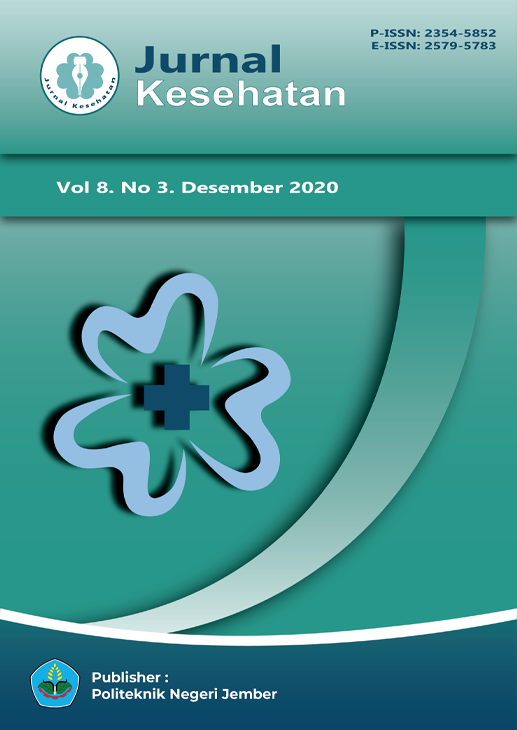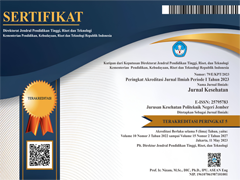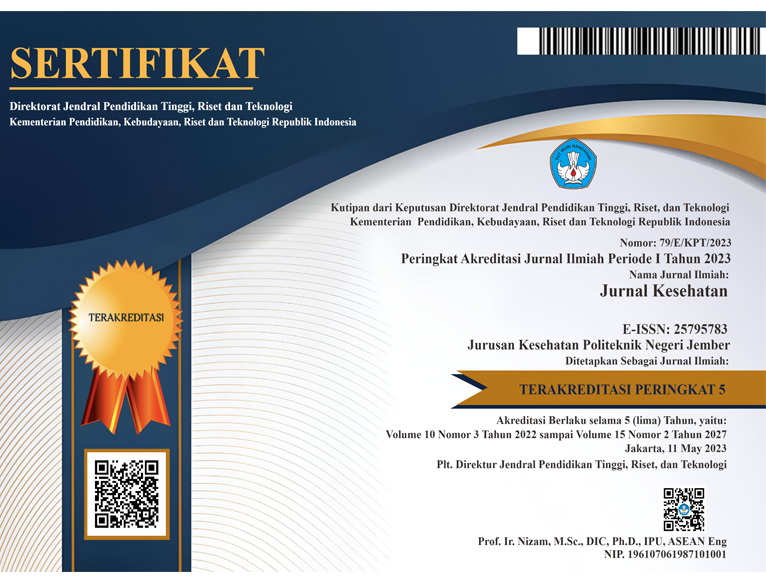Literatur Review : Rapid Immunochromatography Sebagai Metode Skrining Kanker Serviks Berbasis Deteksi Onkoprotein HPV pada Urin
DOI:
10.25047/j-kes.v8i3.164Downloads
Abstract
Cervical cancer is still become main health problem especially in development country. This cancer is the second most common cancer in Indonesian women. It commonly caused by infection of Human Papillomavirus (HPV) type 16 and 18. Actually if cervical cancer was detected earlier, it shows better respond therapy than other cancers, but this opportunity is not supported by appropiate screening methods. Nowadays, pap smear and IVA are commonly used for detect cervical cancer but they only recommend for women who have had sexual intercourse. Both of them also require medical expertise and pap smear is highly cost. Based on these problem, this paper describes novel method for cervical cancer screening by using rapid immunochromatography kit which is more applicative, noninvasive, and affordable. This paper was a literature review (library research). Data obtained through the search engine using keywords: "Cervical Cancer", "HPV", "Urine", "Screening", “Lateral flow test”, and "Rapid immunochromatography". The references were taken from reliable journal in the range of 2009 to 2019. Data was also taken from textbooks and the health institution official sites which support the analysis. This method detect the presence of oncoprotein E6 & E7 of HPV-16 and HPV-18 in urinusing antigen-antibody binding principle. Sensitivity and specificity test done by comparing the results of the kit with the results of pap smear tests as a standard screening method and PCR HPV test on urinsamples. We conclude that with further protocol development and standardization to achieve clinical sensitivity, this kit is a solution for noninvasive detection of high risk cervical cancer so that treatment can be do immediately and the mortality rate due to cervical cancer can be reduced as much as possible.
Keywords:
cervical cancer, HPV 16 & 18, lateral flow test, noninvasive method, urineReferences
American Cancer Society. (2018). Key Statistic for Cervical Cancer. American Cancer Society.
Bahadır, E. B., & Sezgintürk, M. K. (2016). Lateral flow assays: Principles, designs and labels. In TrAC - Trends in Analytical Chemistry. https://doi.org/10.1016/j.trac.2016.06.006
Benard, V. B., Thomas, C. C., King, J., Massetti, G. M., Doria-Rose, V. P., Saraiya, M., & Centers for Disease Control and Prevention (CDC). (2014). Vital signs: cervical cancer incidence, mortality, and screening - United States, 2007-2012. MMWR. Morbidity and Mortality Weekly Report.
Bissett, S. L., Howell-Jones, R., Swift, C., De Silva, N., Biscornet, L., Parry, J. V., Saunders, N. A., Nathan, M., Soldan, K., Szarewski, A., Cuzick, J., & Beddows, S. (2011). Human papillomavirus genotype detection and viral load in paired genital and urine samples from both females and males. Journal of Medical Virology. https://doi.org/10.1002/jmv.22167
Boers, A., Bosgraaf, R. P., van Leeuwen, R. W., Schuuring, E., Heideman, D. A., Massuger, L. F., Verhoef, V. M., Bulten, J., Melchers, W. J., van der Zee, A. G., Bekkers, R. L., & Wisman, G. B. (2014). DNA methylation analysis in self-sampled brush material as a triage test in hrHPV-positive women. British Journal of Cancer. https://doi.org/10.1038/bjc.2014.392
Bray, F., Ferlay, J., Soerjomataram, I., Siegel, R. L., Torre, L. A., & Jemal, A. (2018). Global cancer statistics 2018: GLOBOCAN estimates of incidence and mortality worldwide for 36 cancers in 185 countries. CA: A Cancer Journal for Clinicians. https://doi.org/10.3322/caac.21492
Brown, M. C. (2009). Antibodies: Key to a Robust Lateral Flow Immunoassay. In Lateral Flow Immunoassay. https://doi.org/10.1007/978-1-59745-240-3_4
Chun, P. (2009). Colloidal Gold and Other Labels for Lateral Flow Immunoassays. In Lateral Flow Immunoassay. https://doi.org/10.1007/978-1-59745-240-3_5
Cohen, P. A., Jhingran, A., Oaknin, A., & Denny, L. (2019). Cervical cancer. In The Lancet. https://doi.org/10.1016/S0140-6736(18)32470-X
Consul, S., Agrawal, A., Sharma, H., Bansal, A., Gutch, M., & Jain, N. (2012). Comparative study of effectiveness of Pap smear versus visual inspection with acetic acid and visual inspection with Lugol’s iodine for mass screening of premalignant and malignant lesion of cervix. Indian Journal of Medical and Paediatric Oncology. https://doi.org/10.4103/0971-5851.103143
Cuschieri, K., Nandwani, R., McGough, P., Cook, F., Hogg, L., Robertson, C., & Cubie, H. (2011). Urine testing as a surveillance tool to monitor the impact of HPV immunization programs. Journal of Medical Virology. https://doi.org/10.1002/jmv.22183
de Oliveira, C. M., Musselwhite, L. W., de Paula Pantano, N., Vazquez, F. L., Smith, J. S., Schweizer, J., Belmares, M., Possati-Resende, J. C., de Andrade Vieira, M., Longatto-Filho, A., & Guerreiro Fregnani, J. H. T. (2020). Detection of HPV E6 oncoprotein from urine via a novel immunochromatographic assay. PLoS ONE. https://doi.org/10.1371/journal.pone.0232105
Faridi, R., Zahra, A., Khan, K., & Idrees, M. (2011). Oncogenic potential of human papillomavirus (HPV) and its relation with cervical cancer. In Virology Journal. https://doi.org/10.1186/1743-422X-8-269
Kementerian Kesehatan RI Badan Penelitian dan Pengembangan. (2018). Hasil Utama Riset Kesehatan Dasar. Kementrian Kesehatan Republik Indonesia.
Kim, J. H., Cho, I. H., Seo, S. M., Kim, J. S., Oh, K. H., Kang, H. S., Kim, I. G., & Paek, S. H. (2009). Immuno-chromatographic analysis for HPV-16 and 18 E7 proteins as a biomarker of cervical cancer caused by human papillomavirus. Bulletin of the Korean Chemical Society. https://doi.org/10.5012/bkcs.2009.30.12.2999
Morshed, K., Polz-Gruszka, D., Szymañski, M., & Polz-Dacewicz, M. (2014). Human Papillomavirus (HPV) - Structure, epidemiology and pathogenesis. In Otolaryngologia Polska. https://doi.org/10.1016/j.otpol.2014.06.001
Safenkova, I., Zherdev, A., & Dzantiev, B. (2012). Factors influencing the detection limit of the lateral-flow sandwich immunoassay: A case study with potato virus X. Analytical and Bioanalytical Chemistry. https://doi.org/10.1007/s00216-012-5985-8
Sahasrabuddhe, V. V., Gravitt, P. E., Dunn, S. T., Brown, D., Allen, R. A., Eby, Y. J., Smith, K., Zuna, R. E., Zhang, R. R., Gold, M. A., Schiffman, M., Walker, J. L., Castle, P. E., & Wentzensen, N. (2014). Comparison of human papillomavirus detections in urine, vulvar, and cervical samples from women attending a colposcopy clinic. Journal of Clinical Microbiology. https://doi.org/10.1128/JCM.01623-13
Society, A. C. (2016). Cervical Cancer What is cervical cancer ? American Cancer Society.
Van Amerongen, A., Veen, J., Arends, H. A., & Koets, M. (2018). Lateral flow immunoassays. In Handbook of Immunoassay Technologies: Approaches, Performances, and Applications. https://doi.org/10.1016/B978-0-12-811762-0.00007-
Yetisen, A. K., Akram, M. S., & Lowe, C. R. (2013). Paper-based microfluidic point-of-care diagnostic devices. In Lab on a Chip. https://doi.org/10.1039/c3lc50169h
License
Authors who publish in this journal agree to the following terms:
1. Copyright belongs to the medical journal as a publication
2. The author retains copyright and grants the journal rights to the first publication carried out simultaneously under a Creative Commons Attribution License which allows others to share the work with an acknowledgment of the author's work and initial publication in this journal.
3. Authors may enter into separate additional contractual arrangements for the non-exclusive distribution of the work (eg sending it to an institutional repository or publishing it in a book) with acknowledgment of initial publication in this journal.
4. Authors are permitted and encouraged to post work online (eg in institutional repositories or on their websites) before and during the submission process, as before and larger citations of published work (see Effects of Open Access).
Selengkapnya tentang teks sumber ini














